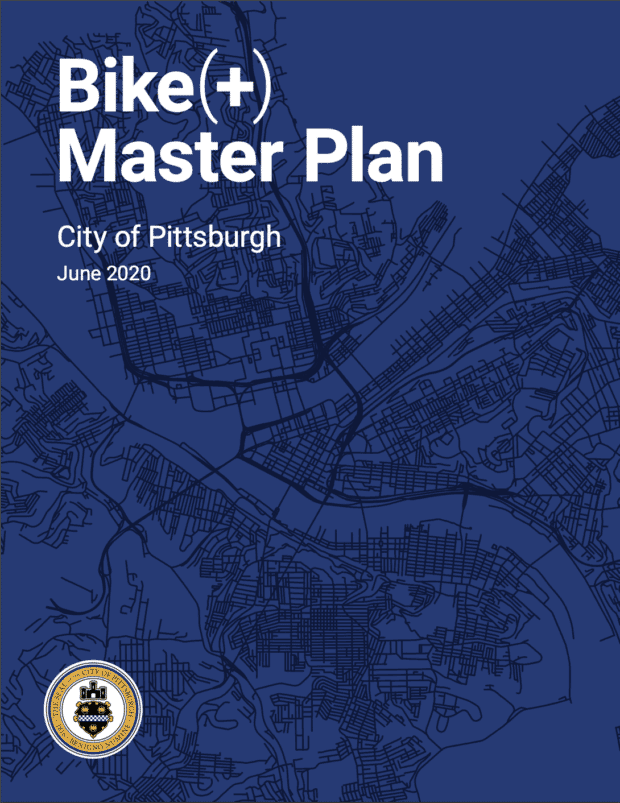
After several false starts and delays, here’s how Pittsburgh got a new bike plan
In late June 2020, the City’s Department of Mobility and Infrastructure (DOMI) published their long awaited Bike(+) Plan. The previous plan, published 21 years ago, was more or less complete by the early 2010s, and we’ve been pushing for a new plan ever since. As recently as a couple weeks ago, Pittsburgh had the oldest bike plan in the United States, out of the largest sixty cities.

Consider this: when the 1999 Bike Plan was drafted, the Eliza Furnace Trail was brand new. The only on-street bike lanes were on Beechwood Blvd, and the Highland Park and Riverview Park loops. Not one Port Authority bus had a bike rack on the front, and there were no sidewalk bike racks to lock to. Today, we have about 58 miles of bike lanes, 6 miles of protected bike lanes, 23 miles of riverfront trails, countless bike racks, a high-tech bike share (that you can rent with your phone), OpenStreetsPGH, and a trail that connects to Washington DC – things whose existence were barely conceivable only two decades ago.
An updated Bike Plan is a necessary tool to provide the vision for bike infrastructure and policies, while setting expectations for residents and politicians. It’s a necessary component in finding the funds to create a street network that brings less stress, less confusion, more safety, and more joy. Additionally, a bike plan will make the desires of residents and the City clear to PennDOT and developers, both of whom alter our public streets. Finally, as this is a ten-year plan, it will provide guidance for any future administrations as they tackle these issues.
In the early 2010s, the City began planning for the publication of a new bike plan reflective of modern times. Over this same time period, bike infrastructure had been rapidly evolving around the United States, and a bike plan was becoming necessary in keeping Pittsburgh up with the times.
Here’s a short history of the long road toward the new Pittsburgh Bike(+) Plan
Timeline
As part of the never-completed MovePGH Comprehensive Plan under Mayor Ravenstahl, the Department of City Planning hosted numerous workshops and public meetings to collect the input to draft a Bike Plan in 2013. BikePGH enthusiastically participated in the planning process and the community outreach toward this draft document.
However, before the plan was formally adopted, Ravenstahl dropped out of the Mayoral race, a factor leading to Mayor Peduto’s election win in 2013, taking office in 2014.
Mayor Peduto, who ran on a complete streets agenda, wanted to take this draft plan and expand upon the work by making it bolder and including the “new” infrastructure types such as protected bike lanes and traffic calming, which were not included in Ravenstahl’s draft plan.
The new Peduto Administration wanted to first pass a Complete Streets Policy, and began the public process towards this initiative, completed in 2016.
Once the Complete Streets Policy passed, the Department of City Planning (DCP) relaunched the bike planning process, and hosted a series of meetings, open houses, and pop-up events to solicit feedback. After DCP completed the public outreach component in 2018, a Mayor Peduto announced the creation of a new department to handle streets and transportation. Called the Department of Mobility and Infrastructure, or DOMI for short, the new leadership had ideas on what should be in a new Bike Plan, and began yet another series of community outreach and data collection.
About two years after the creation of DOMI, they were able to take the Bike(+) Plan across the finish line.
Why the plus(+) in the Bike Plan?
One thing is clear, the period since the 2011 draft plan saw an enormous change in technology. In 2011, people barely understood the potential of cellphones or bike share, and today you are able to rent a bicycle with a few clicks on your smartphone. We also now have to plan for other uses in our bike lanes, such as low-speed stand up scooters and ebikes. The plus(+) in the plan is in recognition of these new mobility types that we’ll most likely see proliferating in the coming years.
Now what?
Ultimately, the Bike(+) Plan calls for 123 miles of bike infrastructure over the next 10 years. In response, DOMI, Bike Pittsburgh, and Healthy Ride have formed a partnership to help rapidly implement the new Bike(+) Plan, as well as market how less stressful streets are beneficial for everyone, regardless of how they use our streets.
The program, dubbed MoveForwardPGH, has already launched an advertising campaign and has begun the outreach and installation of several projects, with the goal of 60 miles of new or improved bike infrastructure over the next two years.
If you’d like to get involved in the next phase of this journey, we encourage you to check out the MoveForwardPGH site, and sign up for updates and volunteer opportunities.